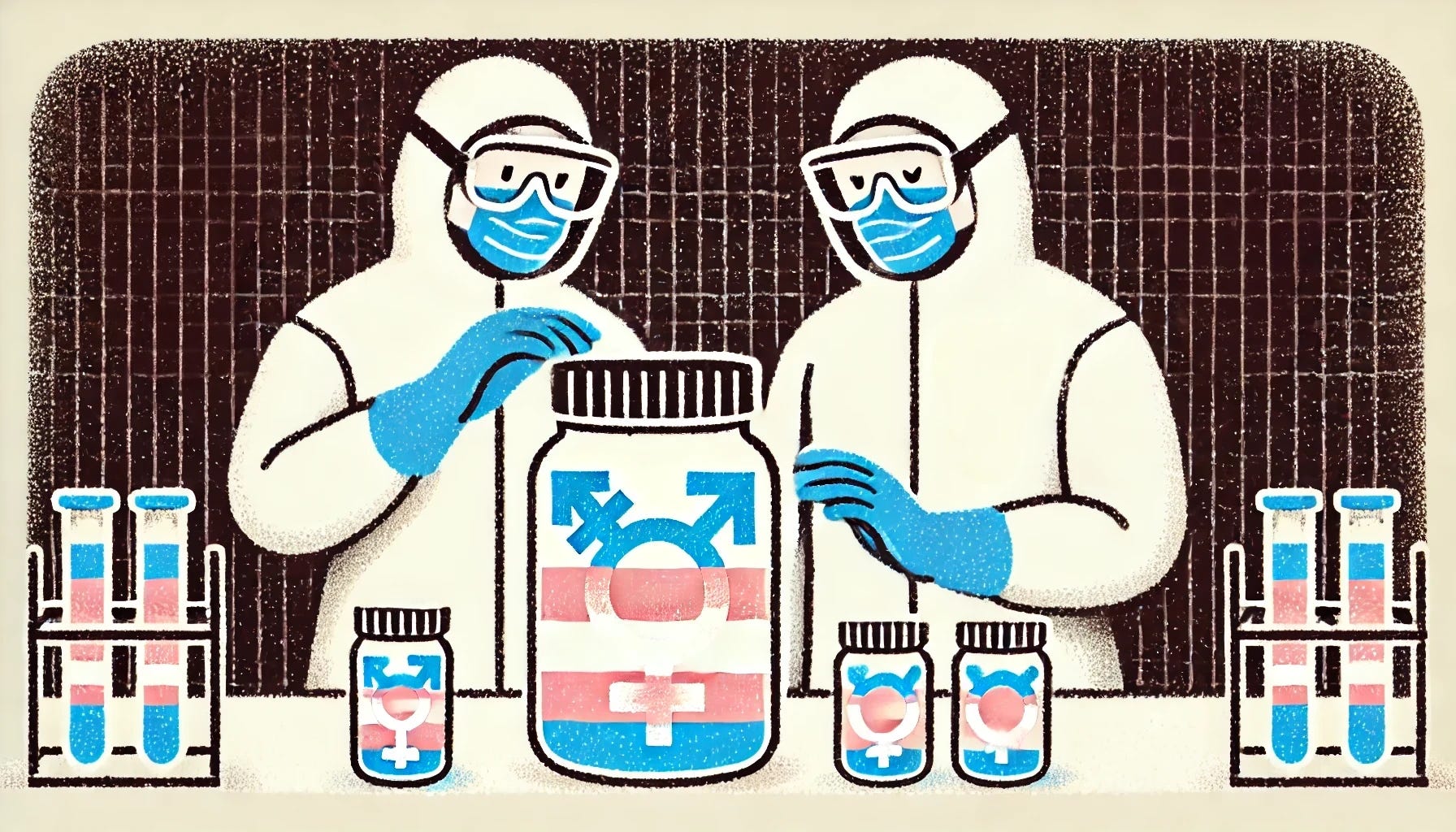Gender Identity as an Academic ‘Lab Leak’
Gender theory shows that, like viruses, ideas can also escape containment and disrupt society.
Reality’s Last Stand is a reader-supported publication. Please consider becoming a paying subscriber or making a one-time or recurring donation to show your support.
About the Author
Tom Sherry is a child and family therapist who has focused on adolescents and parents for the past 25 years. He lives with his wife and son in Asheville, North Carolina. When inspired, he posts to his Substack Chill the F Out.
“What is the sound of one hand clapping?” “If a tree falls in the forest and no one is around to hear it, does it make a sound?” College students around the world have pondered these questions for generations. These fun intellectual exercises help challenge our assumptions and force us to examine ideas we often take for granted.
They’re also the kind of thing people roll their eyes at—fun, sure, but hardly serious. Koans like these are often treated as philosophical party tricks, not pressing matters.
Take a step up in complexity, and you get questions like, “Does free will exist?” Every philosophy major—including me, back in the day—has burned midnight oil debating this one. Today, a number of influential scientists, including neuroscientists Robert Sapolsky and Sam Harris, argue free will is an illusion.
Great. I love science. I love opinions. I value academia. Ideas are a blast. But is the question of free will just a souped-up koan—an abstract puzzle to noodle over—or a question with teeth, one with real-world implications?
This isn’t just navel-gazing about navel-gazing. When we lump every intellectual pursuit together—treating a dorm-room debate about free will with the same gravity as, say, identifying a bird flu strain capable of human-to-human transmission—we risk diluting the value of countless lab researchers working hard to identify future risks to real people’s lives. This is hard science—the same science that probed corona viruses in a lab in Wuhan China and puzzled over retroviruses in the 1980s. These kinds of intellectual pursuits are very valuable. Back then, retrovirus research felt like a niche academic sideline—until it cracked open the HIV crisis and gave us tools to fight it. From microwaves to MRI machines to once-unthinkable treatments, science routinely delivers.
Here’s the catch: all intellectual pursuits, abstract or concrete, carry potential—and peril. A koan may be nothing more than a mental exercise, but what about free will? If Sapolsky and Harris are right, its implications could upend law, morality, even our very sense of self. And then there’s the lab work. Was COVID-19 the result of a viral contagion study that slipped its leash? Maybe. What’s undeniable is that—from the CDC’s test tubes to philosophy’s thought experiments—the stakes are real. A virus can escape containment and kill millions. An idea can break free from the ivory tower and remake—or break—society. In both cases, the fallout can be devastating.
Consider the simple question: What is the distinction between biological sex and gender? It’s a fun, thought-provoking query that has enlightened generations of aspiring intellectuals. Exploring the interplay of biology, familial upbringing, and cultural influences on self-expression is valuable. Feminists have long championed the idea that biology is not destiny, freeing women to succeed in roles traditionally reserved for men and creating space for men to pursue careers as teachers, nurses, and stay-at-home parents. Decades of activism by lesbian, gay, and bisexual individuals reshaped cultural attitudes toward sexual orientation. When the Supreme Court ruled in Obergefell v. Hodges to recognize same-sex marriage, it didn’t fundamentally change ideas about marriage, it merely reflected a hard-fought cultural shift about sexual orientation and civil rights that had already taken place.
Yet, until very recently, no one questioned the reality of biological sex itself as a defining aspect of the human experience. Biological sex is not a product of culture—it is a product of biology.
The nature-versus-nurture debate has fascinated philosophers for ages. Are humans a “blank slate” shaped entirely by culture? Or do innate traits, rooted in our genetic history, define us? In the 1960s, John Money of Johns Hopkins University mutated this perennial question into something new. For the first time, the concepts of what we are and who we are became fully disentangled. He argued that sex and gender were wholly separate, pioneering the idea of “gender identity” as distinct from biological sex.
Three decades later, Judith Butler of UC Berkeley pushed this concept to its extreme. In Gender Trouble: Feminism and the Subversion of Identity, a dense, jargon-laden academic treatise, she suggested that biological sex itself is a social construct. The book was not written for the general public—let alone as a guide to living a fulfilling life.
But what happens when this once-obscure academic idea—that sex and gender are entirely separate—escapes the confines of academia and takes root in an image-obsessed, polarized, and social media-driven world?
Consider what might unfold if a group of influential academics persuaded major institutions and much of the public that “free will” does not exist. (After all, many already believe this and claim to have data supporting their position.) Imagine the upheaval in the court system, schools, and every other institution if people began to assert, “I had no choice—there is no free will.”
These benign intellectual exercises can be valuable—as intellectual exercises. But virulent pathogens are not the only dangerous thing that can leak from the halls of academic exploration. The concept of a “gender identity” as wholly separate from biological sex has, in a remarkably short time, infected much of the Western world.
“Gender identity” is an academic “lab leak.” It was never meant to take hold in the general public. It was a theoretical playground where scholars competed to outdo one another in journals few people read. But this useful “thought experiment” escaped its rightful domain and contaminated our schools, government institutions, and mainstream culture. Sex and gender are no longer considered synonyms; in fact, gender has supplanted sex as the primary marker. The now-ubiquitous phrase “Sex Assigned at Birth” on medical intake forms indicates how deeply this transformation and infiltrated our everyday life. The slogan "Trans women are women" is another example of this ideological capture.
Throughout history, males and females have chosen to present as the opposite sex. That is not new. What is new is the claim that an internal sense of gender overrides biological sex—an assertion that who we believe we are determines what we are. These postmodern ideas might remain harmless word games if they were not taken seriously. But treating subjective identity as more real than objective biology has serious consequences.
We now see males in female prisons, locker rooms, and sports. The medicalization of sex-nonconforming children is promoted as common sense among the intelligentsia. And those who reject these esoteric ideas—concepts as abstract as the sound of one hand clapping—are dismissed as uneducated, unenlightened, or bigoted.
It was fun exploring abstract ideas as a 20-something college student. But how do these intellectual exercises play out in the real world? How would our social order and institutions function if everyone accepted Robert Sapolsky’s contention that free will does not exist?
Well, here we are. Biological sex does exist. Denying that truth fosters chaos and confusion, particularly among adolescents. I remain ambivalent about whether “gender identity” is real—some people seem to have a strong sense of it, while others do not. And surely there is a minuscule population of adults whose subjective sense of self and objective biology are so incongruent that seeking medical interventions may alleviate some distress. But biological sex is an objective fact, one that cannot be erased by progressive ideology or the mere existence of a rare mental condition. Gender, as a concept, is best confined to the halls of academia—much like the study of coronaviruses would have been best contained within the labs of Wuhan.
For now, we must wade through a sea of distracted children waving one hand in the air listening for a sound or asking, “Am I really a girl?”
Wow, you made it to the end! You must have enjoyed it. If so, please consider upgrading to a paid subscription or making a recurring or one-time donation below. Reality’s Last Stand is a reader-supported publication, and your help is greatly appreciated.













I also think of this like a game of telephone, where, whatever the concept was while in academia, it has now been altered in absurd and destructive ways.
Love this analogy and agree.
Gender ideology derives from critical gender theory. All critical theory is fake scholarship and a toxic parasitic mind virus.